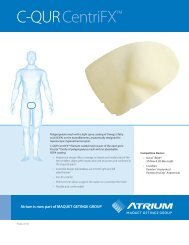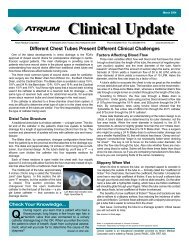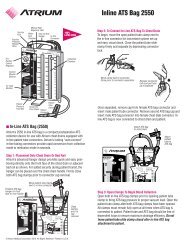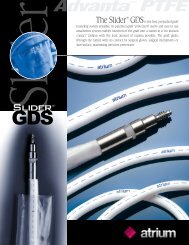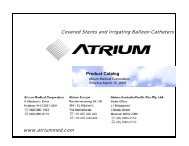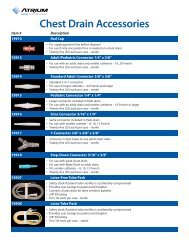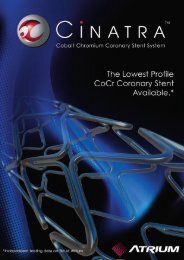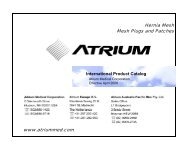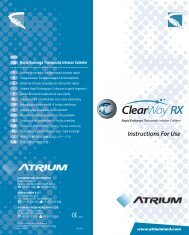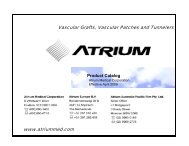Mini Instructions for Use - Atrium Medical Corporation
Mini Instructions for Use - Atrium Medical Corporation
Mini Instructions for Use - Atrium Medical Corporation
You also want an ePaper? Increase the reach of your titles
YUMPU automatically turns print PDFs into web optimized ePapers that Google loves.
<strong>Instructions</strong> For <strong>Use</strong><br />
©2010<br />
<strong>Atrium</strong> and Express<br />
are trademarks of<br />
<strong>Atrium</strong> <strong>Medical</strong> <strong>Corporation</strong><br />
Rev. 2010/04<br />
002547<br />
www.atriummed.com
+<br />
GB<br />
<strong>Instructions</strong> For <strong>Use</strong><br />
Air<br />
Description<br />
The <strong>Atrium</strong> Express <strong>Mini</strong> 500 Dry Seal Chest Drain is a<br />
disposable, waterless operating system with 500ml<br />
collection volume, a non-adjustable dry suction regulator<br />
preset at -20cmH 2 O, and a dry one-way valve <strong>for</strong> seal<br />
protection.<br />
Indications For <strong>Use</strong><br />
• To evacuate air and/or fluid from the chest cavity or<br />
mediastinum.<br />
• To help re-establish lung expansion and restore<br />
breathing dynamics.<br />
• To facilitate early ambulation of post surgical patients<br />
who require chest drainage.<br />
Warnings<br />
1. Do not obstruct positive pressure relief valve located on<br />
top of drain.<br />
2. Do not separate in-line connector prior to clamping off<br />
patient tube.<br />
3. Do not keep patient tube clamp closed during drainage<br />
collection or patient transport.<br />
4. Do not use if fluid drainage is expected to be in excess<br />
of 500ml per day.<br />
5. Do not connect any open luer-lock connector to the<br />
needleless luer port located on the front of the drain.<br />
6. Do not use or puncture needleless luer port with needle.<br />
7. Do not puncture patient tube with an 18 gauge or larger<br />
needle.<br />
8. For single patient use only. Do not reuse, reprocess or<br />
resterilize. Reuse, reprocessing or re-sterilization may<br />
compromise the structural integrity of the device and/or<br />
lead to device failure which, in turn, may result in<br />
patient injury, illness or death.<br />
Precautions<br />
1. Chest drain must be kept in an upright position and<br />
below the patient's chest.<br />
2. Replace chest drain if damaged or when collection<br />
volume meets or exceeds maximum capacity.<br />
Set Up<br />
Step 1.<br />
Step 2.<br />
Step 3.<br />
Step 4.<br />
Step 5.<br />
Select Catheter Adapter - Select appropriate<br />
adapter and secure firmly into distal end of<br />
patient tube.<br />
Connect Patient Tube To Patient - Close patient<br />
tube clamp prior to connecting patient tube to<br />
catheter. Insert connector firmly into catheter.<br />
Connect Patient Tube To Chest Drain - Remove<br />
red disposal cap. Connect patient tube to chest<br />
drain.<br />
Open Patient Tube Clamp - Clamp must remain<br />
open at all times when system is connected to<br />
patient. Open clamp prior to initiating suction.<br />
Connecting To Suction - When suction is<br />
prescribed by the physician, firmly attach suction<br />
line to suction port. Slowly increase suction<br />
source vacuum to -80mmHg or higher. The<br />
suction control regulator is preset to -20cmH 2 O.<br />
Placement of Unit<br />
During patient ambulation or when patient is confined to<br />
bedrest, always place unit below patient’s chest in upright<br />
position. <strong>Use</strong> hanger provided <strong>for</strong> bed rail attachment. Only<br />
use belt straps as directed <strong>for</strong> patient ambulation.<br />
Suction Port<br />
When suction is required, firmly attach suction source line<br />
to suction port located on top of chest drain.<br />
Suction Source<br />
Suction source should provide a minimum vacuum<br />
pressure of -80mmHg at 20 liters of airflow per minute.<br />
Fixed Suction Regulator<br />
The non-adjustable dry suction regulator is preset at<br />
-20cmH 2 O vacuum setting and will automatically<br />
compensate <strong>for</strong> moderate changes in vacuum source<br />
pressure.<br />
Dry One-Way Seal Valve<br />
<strong>Atrium</strong>'s dry seal valve does not require water <strong>for</strong> seal<br />
protection during patient use. <strong>Atrium</strong>'s one-way dry seal<br />
valve is not position sensitive.<br />
Vacuum Indicator<br />
A mark symbol is visible in the vacuum indicator window<br />
when vacuum is present inside the chest drain. When no<br />
vacuum is present inside chest drain, the mark symbol<br />
will not appear.<br />
Collection Chamber<br />
The collection chamber is calibrated in 10ml increments up<br />
to a maximum capacity of 500ml. Fluid level graduations<br />
are accurate within ± 10ml or 5% of scale.<br />
Leak Detection<br />
Fluid must be present in the collection chamber <strong>for</strong> air leak<br />
detection. If fluid is not present, add 20ml of sterile water<br />
or saline through the needleless access port located on the<br />
front of the drain. Temporarily tip the drain to the right as<br />
shown until collection fluid appears in the air leak window<br />
(A). Bubbling in the air leak window (A) when positioned<br />
as shown, will confirm a patient air leak. Immediately<br />
return chest drain to upright position.<br />
Automatic High Negativity Release<br />
The filtered high negativity release valve located on the<br />
back wall of the chest drain automatically activates to limit<br />
maximum vacuum pressure to approximately -50cmH 2 O.<br />
Positive Pressure Relief Valve<br />
PPRV located on top of the chest drain opens instantly to<br />
release positive pressure automatically.<br />
Sampling Patient Drainage<br />
Sampling patient drainage must be in accordance with<br />
approved hospital infection control standards. Fluid<br />
samples can be taken directly from the needleless access<br />
port located on the front of the drain or from the patient<br />
tube by <strong>for</strong>ming a temporary dependent loop and inserting<br />
a 20 gauge needle at an oblique angle. Do not puncture<br />
patient tube with an 18 gauge or larger needle.<br />
System Disconnection<br />
Clamp off all indwelling thoracic catheters prior to<br />
disconnecting chest drain from patient. Following patient<br />
line removal from chest drain, insert the blunt end of the<br />
red disposal cap into the patient line port to close off the<br />
collection chamber <strong>for</strong> disposal.<br />
System Disposal<br />
Disposal of chest drain and its contents should be in<br />
accordance with all applicable regulations.<br />
SYMBOLS USED ON PRODUCT LABELS<br />
REF CODE NUMBER LOT LOT NUMBER<br />
STERILE EO STERILE. STERILIZED BY ETHYLENE OXIDE.<br />
SEE PACKAGE INSERT<br />
Rx Only<br />
SINGLE USE ONLY<br />
PRESCRIPTION ONLY<br />
This device is covered under one or more of the following U.S. patents:<br />
4,988,342; 5,114,416; 5,141,504; 5,154,712; 5,380,314; 5,397,299;<br />
5,401,262; 5,807,358; 6,210,383 B1; 6,358,218 B1<br />
Other patents pending.<br />
<strong>Atrium</strong> and Express are trademarks of <strong>Atrium</strong> <strong>Medical</strong> <strong>Corporation</strong>.<br />
©2010 All Rights Reserved.<br />
EXPIRATION DATE<br />
ATRIUM MEDICAL CORPORATION<br />
ATRIUM MEDICAL EUROPE B.V.<br />
5 Wentworth Drive, Hudson, New Hampshire 03051 U.S.A. Rendementsweg 20 B, 3641 SL Mijdrecht, The Netherlands<br />
603-880-1433 603-880-6718<br />
+31-297-230-420 +31-297-282-653
E<br />
F<br />
G<br />
D<br />
A<br />
C<br />
B<br />
H<br />
USA<br />
GB<br />
Features:<br />
F<br />
Comprend:<br />
D<br />
Merkmale:<br />
E<br />
Características:<br />
I<br />
Caratteristiche:<br />
P<br />
Características:<br />
NL<br />
Onderdelen:<br />
GR<br />
J



